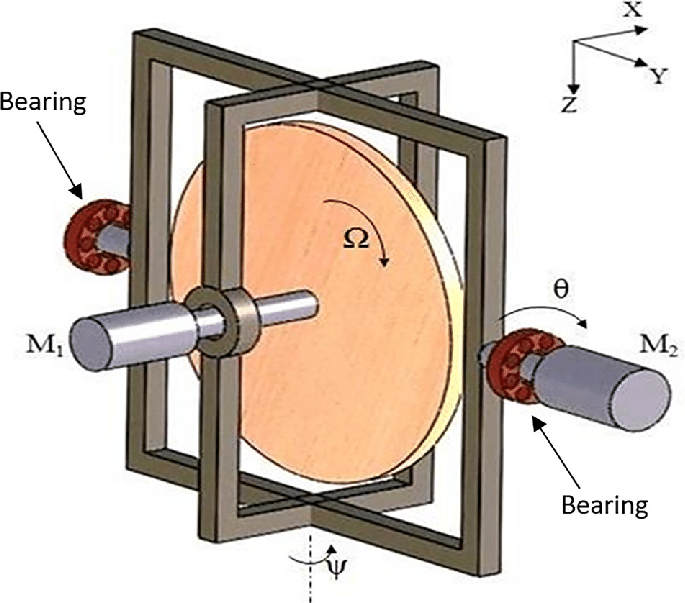Gyroscopic inertia is an essential concept to understand when studying physics. It explains how a spinning object maintains its static orientation in the absence of external forces. It also has numerous applications in engineering, aerospace technology, and navigation systems. In this article, we will discuss the fundamentals of gyroscopic inertia and how it works. We will also look at some examples of how it is used in everyday life and explore the potential for further research into this area.
Gyroscopic Inertia

Gyroscopic inertia is a term used to describe the rotating motion of an object. It refers to the resistance that an object has to changes in its rotational motion. This phenomenon can be observed in many everyday objects, such as spinning tops and bicycle wheels.
The gyroscopic effect is caused by the angular momentum of an object. Angular momentum is a property of any rotating body which depends on both its mass and speed of rotation. The greater the mass or speed, the greater its angular momentum will be. Therefore, when an object with high angular momentum is set into motion, it tends to resist any forces that would change its direction or speed.
Gyroscopic inertia has practical applications in various fields such as aviation and navigation technology. In airplanes, for example, gyroscopes are used to provide stability and maintain orientation during flight. Similarly, gyroscope-based navigation systems are widely used in submarines and spacecraft where traditional navigational aids such as GPS may not be reliable or available at all times.
Definition
A gyroscopic inertia is a phenomenon observed in rotating objects. It refers to the property of an object in motion that tends to resist any change in its direction or orientation, due to the laws of physics governing rotational motion. This effect is produced by the angular momentum of the object, which is proportional to both its mass and the speed at which it rotates.
In practical terms, this means that gyroscopes can be used for a variety of purposes, including navigation, stabilization and control systems. For example, gyroscopes are commonly used in airplanes and spacecraft to help maintain stability during flight. They are also used in cameras and other devices that need to remain steady while capturing images or video.
Overall, understanding how a gyroscopic inertia works is essential for anyone working with rotating objects or systems. By harnessing this powerful property of physics, engineers and scientists can create advanced technologies that enhance our lives in countless ways.
Mechanics

Gyroscopic inertia is a concept that is commonly seen in the mechanics of various vehicles, machines and even toys. It refers to the tendency of an object with spinning motion to resist any forces that try to change its axis of rotation. This means that objects with gyroscopic inertia maintain their orientation regardless of external forces acting on them, which can have significant implications for stability and control.
The principle behind gyroscopic inertia lies in the fact that spinning objects possess angular momentum, which is a measure of the rotational motion they possess. When an object spins, its angular momentum creates a force (known as torque) perpendicular to its axis of rotation. This torque causes the object to resist any attempts at changing its orientation or direction. In everyday life, we may encounter examples of gyroscopic inertia in objects such as tops and bicycles, where the spinning wheels help keep them upright even when subjected to external forces like wind or bumps on the road.
Gyroscopic inertia has many practical applications across various fields including aviation, engineering and physics research. Understanding how it works can help designers create more stable and efficient machines while also advancing our understanding of fundamental physical principles governing movement and energy transfer.
Examples of Use
One example of the use of gyroscopic inertia is in gyroscopes. A gyroscope consists of a spinning rotor that maintains its axis of rotation, even when subjected to external forces. This is due to the gyroscopic inertia created by the spinning rotor, which resists any change in its orientation. This property makes gyroscopes useful in navigation and stabilization systems, such as those used in aircraft and spacecraft.
Another example of the use of gyroscopic inertia is in bicycles. When a rider turns a bicycle, the wheels create a rotating motion that generates gyroscopic forces. These forces help keep the bike stable during turns by resisting any changes to its orientation. Without this stabilization from gyroscopic inertia, it would be much more difficult for a rider to maintain balance while turning at higher speeds or on uneven terrain.
Overall, understanding how gyroscopic inertia works can provide insight into various applications where stability and orientation are crucial factors. From navigational tools to everyday modes of transportation, these principles play an important role in ensuring safety and efficiency across multiple industries.
Advantages
One of the main advantages of using a gyroscopic inertia is that it provides stability and balance to machines and vehicles. Gyroscopes have been used for centuries in various applications, from navigation instruments to toys like tops. In vehicles such as airplanes and helicopters, gyroscopes help maintain stability by resisting any deviation from their original position.
Another advantage of using a gyroscopic inertia is its ability to resist external forces. The spinning motion of the gyroscope creates an angular momentum that keeps it stable even when subjected to forces such as gravity or vibration. This makes them useful in machines such as washing machines, where they help reduce vibrations caused by unbalanced loads.
A third advantage of using a gyroscopic inertia is its precision and accuracy. Due to their ability to resist external forces, gyros are often used in navigation systems such as compasses or GPS receivers. They can also be used in scientific instruments like telescopes or microscopes, where precise movements are required without any interference from outside factors. Overall, the use of gyroscopic inertia has numerous advantages across various industries and applications due to its stability, resistance abilities, and precision.
Limitations
Gyroscopic inertia is a fascinating physical phenomenon that has a variety of applications in engineering and technology. However, it also has certain limitations that must be taken into account when designing systems that rely on its effects. One important limitation of gyroscopic inertia is the fact that it only works effectively at high speeds. At low speeds, the gyroscopic effect becomes negligible and may even be counterproductive.
Another limitation of gyroscopic inertia is its sensitivity to external forces and vibrations. Any disturbance or imbalance in the system can cause the gyroscope to wobble or drift, which can lead to instability or even failure of the device. This makes it essential to design gyroscopes with sufficient damping and stabilization mechanisms to mitigate these effects.
Despite these limitations, gyroscopic inertia remains an incredibly useful tool for engineers and scientists working in fields such as aerospace, robotics, and navigation. By understanding these limitations and working within their constraints, designers can harness this powerful principle to create innovative new technologies that push the boundaries of what is possible.
In conclusion, gyroscopic inertia is an essential concept in physics that plays a significant role in various applications. The principle behind the gyroscopic effect is that a spinning object resists any change in its orientation or direction of motion unless acted upon by an external force. This property makes gyroscopes valuable instruments for navigation, aviation, and space exploration.
In practical applications, the gyroscopic effect comes into play when using devices such as drones and helicopters to stabilize their movements. It also helps maintain balance on bicycles and motorcycles by keeping them upright during turns or sudden changes in direction. In addition to these applications, the gyroscope has found its way into various fields of study such as medicine, engineering, and even entertainment.
Overall, understanding how a gyroscopic inertia works is crucial for scientists and engineers who wish to develop innovative technologies that rely on this principle. As technology continues to evolve rapidly, it’s highly likely that we will continue to see new applications for this fascinating phenomenon emerge in the future.





Leave a Reply